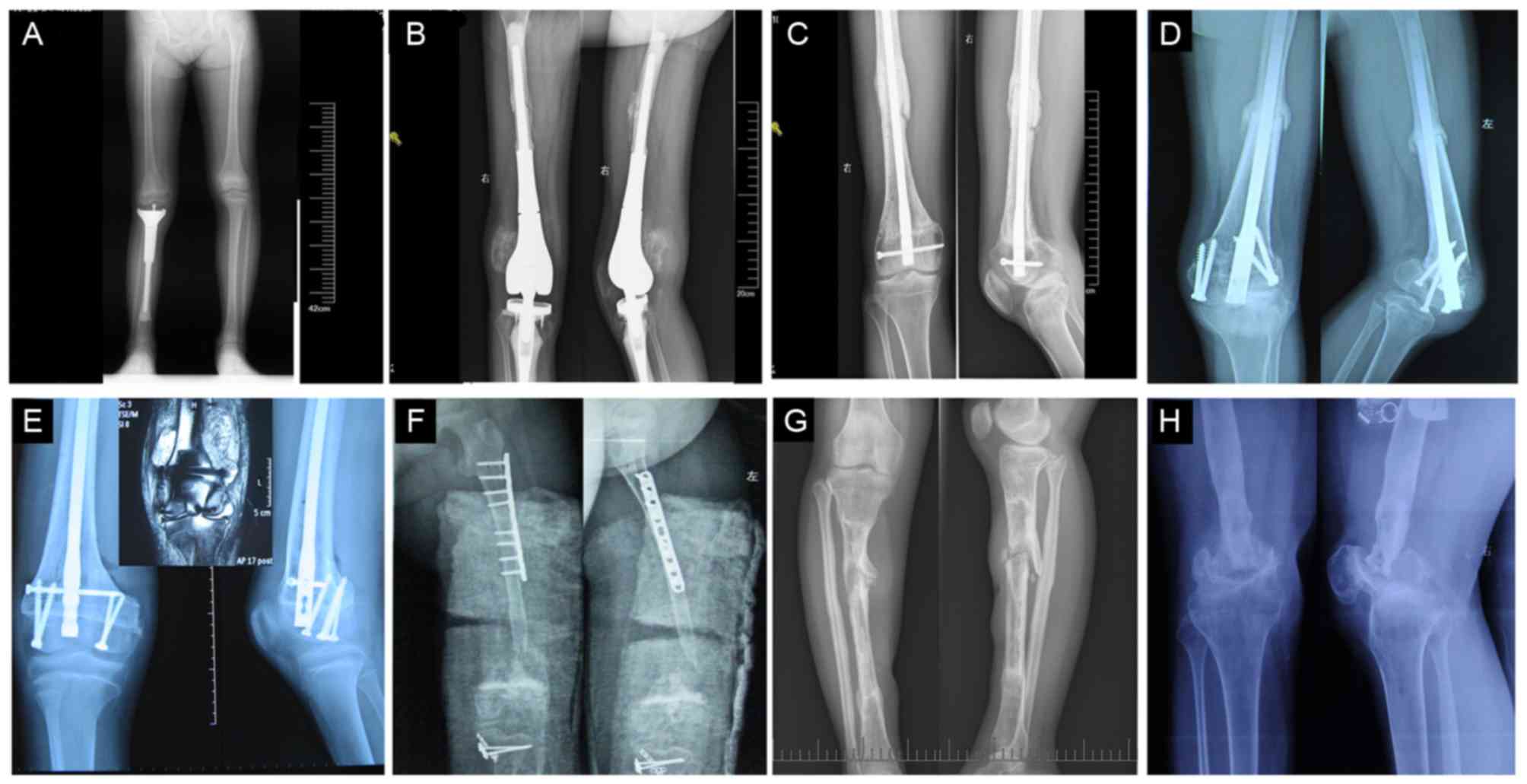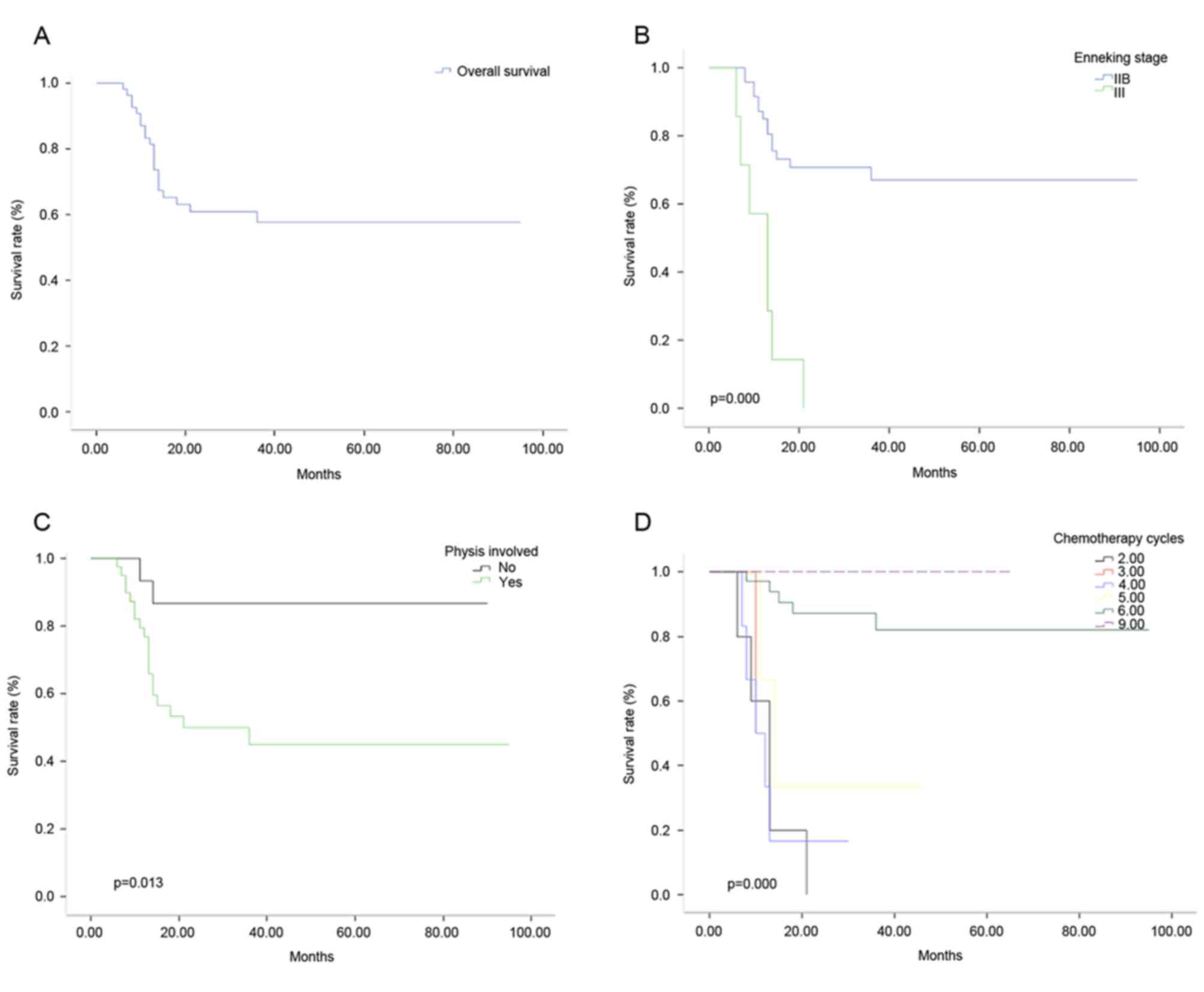|
1
|
Ottaviani G and Jaffe N: The epidemiology
of osteosarcoma. Cancer Treat Res. 152:3–13. 2009. View Article : Google Scholar : PubMed/NCBI
|
|
2
|
Chen Y, Yu XC, Xu SF, Xu M and Song RX:
Impacts of tumor location, nature and bone destruction of extremity
osteosarcoma on selection of limb salvage operative procedure.
Orthop Surg. 8:139–149. 2016. View
Article : Google Scholar : PubMed/NCBI
|
|
3
|
Haynes K, Tyner C and Williams PD:
Repiphysis prosthesis for limb preservation in pediatric patients
with bone cancer: A literature review. Orthop Nurs. 32:81–86. 2013.
View Article : Google Scholar : PubMed/NCBI
|
|
4
|
Kudawara I, Aoki Y, Ueda T, Araki N, Naka
N, Nakanishi H, Matsumine A, Ieguchi M, Mori S, Myoui A, et al:
Neoadjuvant and adjuvant chemotherapy with high-dose ifosfamide,
doxorubicin, cisplatin and high-dose methotrexate in non-metastatic
osteosarcoma of the extremities: A phase II trial in Japan. J
Chemother. 25:41–48. 2013. View Article : Google Scholar : PubMed/NCBI
|
|
5
|
Hegyi M, Semsei AF, Jakab Z, Antal I, Kiss
J, Szendroi M, Csoka M and Kovacs G: Good prognosis of localized
osteosarcoma in young patients treated with limb-salvage surgery
and chemotherapy. Pediatr Blood Cancer. 57:415–422. 2011.
View Article : Google Scholar : PubMed/NCBI
|
|
6
|
Eleutério SJ, Senerchia AA, Almeida MT, Da
Costa CM, Lustosa D, Calheiros LM, Barreto JH, Brunetto AL, Macedo
CR and Petrilli AS: Osteosarcoma in patients younger than 12 years
old without metastases have similar prognosis as adolescent and
young adults. Pediatr Blood Cancer. 62:1209–1213. 2015. View Article : Google Scholar : PubMed/NCBI
|
|
7
|
Ruzbarsky JJ, Goodbody C and Dodwell E:
Closing the growth plate: A review of indications and surgical
options. Curr Opin Pediatr. 29:80–86. 2017. View Article : Google Scholar : PubMed/NCBI
|
|
8
|
Hao YK, Zhang YK, Yang ZP, Li X, Yang Q
and Li JM: The accuracy of magnetic resonance imaging in
determining the osteotomy plane in osteosarcoma. Orthopedics.
31:5442008. View Article : Google Scholar : PubMed/NCBI
|
|
9
|
Kumta SM, Chow TC, Griffith J, Li CK, Kew
J and Leung PC: Classifying the location of osteosarcoma with
reference to the epiphyseal plate helps determine the optimal
skeletal resection in limb salvage procedures. Arch Orthop Trauma
Surg. 119:327–331. 1999. View Article : Google Scholar : PubMed/NCBI
|
|
10
|
Enneking WF, Springfield D and Gross M:
The surgical treatment of parosteal osteosarcoma in long bones. J
Bone Joint Surg Am. 67:125–135. 1985. View Article : Google Scholar : PubMed/NCBI
|
|
11
|
Skorupski KA, Uhl JM, Szivek A, Frazier
Allstadt SD, Rebhun RB and Rodriguez CO Jr: Carboplatin versus
alternating carboplatin and doxorubicin for the adjuvant treatment
of canine appendicular osteosarcoma: A randomized, phase III trial.
Vet Comp Oncol. 14:81–87. 2016. View Article : Google Scholar : PubMed/NCBI
|
|
12
|
Schwartz CL, Wexler LH, Krailo MD, Teot
LA, Devidas M, Steinherz LJ, Goorin AM, Gebhardt MC, Healey JH,
Sato JK, et al: Intensified chemotherapy with dexrazoxane
cardioprotection in newly diagnosed nonmetastatic osteosarcoma: A
report from the children's oncology group. Pediatr Blood Cancer.
63:54–61. 2016. View Article : Google Scholar : PubMed/NCBI
|
|
13
|
Yu W, Tang L, Lin F, Yao Y and Shen Z:
Pirarubicin versus doxorubicin in neoadjuvant/adjuvant chemotherapy
for stage IIB limb high-grade osteosarcoma: Does the analog matter?
Med Oncol. 32:3072015. View Article : Google Scholar : PubMed/NCBI
|
|
14
|
American Association of Tissue Banks:
American Association of Tissue Banks provisional guidelines for
cell, tissue and organ preservation: Reproductive council
guidelines. Newsl Am Assoc Tissue Banks. 4 Suppl:S37–S40. 1980.
|
|
15
|
Tsuchiya H, Abdel-Wanis ME, Sakurakichi K,
Yamashiro T and Tomita K: Osteosarcoma around the knee.
Intraepiphyseal excision and biological reconstruction with
distraction osteogenesis. J Bone Joint Surg Br. 84:1162–1166. 2002.
View Article : Google Scholar : PubMed/NCBI
|
|
16
|
Cañadell J, Forriol F and Cara JA: Removal
of metaphyseal bone tumours with preservation of the epiphysis.
Physeal distraction before excision. J Bone Joint Surg Br.
76:127–132. 1994.PubMed/NCBI
|
|
17
|
Enneking WF, Dunham W, Gebhardt MC,
Malawar M and Pritchard DJ: A system for the functional evaluation
of reconstructive procedures after surgical treatment of tumors of
the musculoskeletal system. Clin Orthop Relat Res. 286:241–246.
1993.
|
|
18
|
Tan PX, Yong BC, Wang J, Huang G, Yin JQ,
Zou CY, Xie XB, Tang QL and Shen JN: Analysis of the efficacy and
prognosis of limb-salvage surgery for osteosarcoma around the knee.
Eur J Surg Oncol. 38:1171–1177. 2012. View Article : Google Scholar : PubMed/NCBI
|
|
19
|
Bi W, Wang W, Han G, Jia J and Xu M:
Osteosarcoma around the knee treated with neoadjuvant chemotherapy
and a custom-designed prosthesis. Orthopedics. 36:e444–e450. 2013.
View Article : Google Scholar : PubMed/NCBI
|
|
20
|
Houdek MT, Watts CD, Wyles CC, Rose PS,
Taunton MJ and Sim FH: Functional and oncologic outcome of cemented
endoprosthesis for malignant proximal femoral tumors. J Surg Oncol.
114:501–506. 2016. View Article : Google Scholar : PubMed/NCBI
|
|
21
|
Ieguchi M, Hoshi M, Aono M, Takada J,
Ohebisu N, Kudawara I and Nakamura H: Knee reconstruction with
endoprosthesis after extra-articular and intra-articular resection
of osteosarcoma. Jpn J Clin Oncol. 44:812–817. 2014. View Article : Google Scholar : PubMed/NCBI
|
|
22
|
Hahn SB, Park HJ, Kim HS, Kim SH and Shin
KH: Surgical treatment of malignant and aggressive bone tumors
around the knee by segmental resection and rotationplasty. Yonsei
Med J. 44:485–492. 2003. View Article : Google Scholar : PubMed/NCBI
|
|
23
|
Campanacci L, Alì N, Casanova JM, Kreshak
J and Manfrini M: Resurfaced allograft-prosthetic composite for
proximal tibial reconstruction in children: Intermediate-term
results of an original technique. J Bone Joint Surg Am. 97:241–250.
2015. View Article : Google Scholar : PubMed/NCBI
|
|
24
|
Abdel-Ghani H, Ebeid W and El-Barbary H:
Management of combined nonunion and limb-length discrepancy after
vascularised fibular grafting. J Bone Joint Surg Br. 92:267–272.
2010. View Article : Google Scholar : PubMed/NCBI
|
|
25
|
Cipriano CA, Gruzinova IS, Frank RM,
Gitelis S and Virkus WW: Frequent complications and severe bone
loss associated with the repiphysis expandable distal femoral
prosthesis. Clin Orthop Relat Res. 473:831–838. 2015. View Article : Google Scholar : PubMed/NCBI
|
|
26
|
Sawamura C, Matsumoto S, Shimoji T, Ae K,
Tanizawa T, Gokita T, Koyanagi H and Okawa A: Indications for and
surgical complications of rotationplasty. J Orthop Sci. 17:775–781.
2012. View Article : Google Scholar : PubMed/NCBI
|
|
27
|
Forni C, Gaudenzi N, Zoli M, Manfrini M,
Benedetti MG, Pignotti E and Chiari P: Living with
rotationplasty-quality of life in rotationplasty patients from
childhood to adulthood. J Surg Oncol. 105:331–336. 2012. View Article : Google Scholar : PubMed/NCBI
|
|
28
|
Dotan A, Dadia S, Bickels J, Nirkin A,
Flusser G, Issakov J, Neumann Y, Cohen I, Ben-Arush M, Kollender Y
and Meller I: Expandable endoprosthesis for limb-sparing surgery in
children: Long-term results. J Child Orthop. 4:391–400. 2010.
View Article : Google Scholar : PubMed/NCBI
|
|
29
|
Arteau A, Lewis VO, Moon BS, Satcher RL,
Bird JE and Lin PP: Tibial growth disturbance following distal
femoral resection and expandable endoprosthetic reconstruction. J
Bone Joint Surg Am. 97:e722015. View Article : Google Scholar : PubMed/NCBI
|
|
30
|
Abed YY, Beltrami G, Campanacci DA,
Innocenti M, Scoccianti G and Capanna R: Biological reconstruction
after resection of bone tumours around the knee: Long-term
follow-up. J Bone Jt Surg Br. 91:1366–1372. 2009. View Article : Google Scholar
|
|
31
|
Bus MP, Dijkstra PD, van de Sande MA,
Taminiau AH, Schreuder HW, Jutte PC, van der Geest IC, Schaap GR
and Bramer JA: Intercalary allograft reconstructions following
resection of primary bone tumors: A nationwide multicenter study. J
Bone Joint Surg Am. 96:e262014. View Article : Google Scholar : PubMed/NCBI
|
|
32
|
Aponte-Tinao L, Ayerza MA, Muscolo DL and
Farfalli GL: Survival, recurrence and function after epiphyseal
preservation and allograft reconstruction in osteosarcoma of the
knee. Clin Orthop Relat Res. 473:1789–1796. 2015. View Article : Google Scholar : PubMed/NCBI
|
|
33
|
DeGroot H III and Mankin H: Total knee
arthroplasty in patients who have massive osteoarticular
allografts. Clin Orthop Relat Res. 373:62–72. 2000. View Article : Google Scholar
|
|
34
|
Muscolo DL, Ayerza MA, Aponte-Tinao LA and
Ranalletta M: Partial epiphyseal preservation and intercalary
allograft reconstruction in high-grade metaphyseal osteosarcoma of
the knee. J Bone Joint Surg Am. 86:2686–2693. 2004. View Article : Google Scholar : PubMed/NCBI
|
|
35
|
Karakaşli A, Satoğlu İS and Havitçioğlu H:
A new intramedullary sustained dynamic compression nail for the
treatment of long bone fractures: A biomechanical study. Eklem
Hastalik Cerrahisi. 26:64–71. 2015. View Article : Google Scholar : PubMed/NCBI
|
|
36
|
Bus MP, Dijkstra PD, van de Sande MA,
Taminiau AH, Schreuder HW, Jutte PC, vander Geest IC, Schaap GR and
Bramer JA: Intercalary allograft reconstructions following
resection of primary bone tumors: A nationwide multicenter study. J
Bone Joint Surg Am. 96:e262014. View Article : Google Scholar : PubMed/NCBI
|
|
37
|
Hornicek FJ, Gebhardt MC, Tomford WW,
Sorger JI, Zavatta M, Menzner JP and Mankin HJ: Factors affecting
nonunion of the allograft-host junction. Clin Orthop Relat Res.
382:87–98. 2001. View Article : Google Scholar
|
|
38
|
Faisham WI, Saad Mat AZ, Alsaigh LN, Azman
Nor MZ, Imran Kamarul M, Biswal BM, Bhavaraju VM, Salzihan MS,
Hasnan J, Ezane AM, et al: Prognostic factors and survival rate of
osteosarcoma: A single-institution study. Asia Pac J Clin Oncol.
13:e104–e110. 2017. View Article : Google Scholar : PubMed/NCBI
|
|
39
|
Ayerza MA, Farfalli GL, Aponte-Tinao L and
Muscolo DL: Does increased rate of limb-sparing surgery affect
survival in osteosarcoma? Clin Orthop Relat Res. 468:2854–2859.
2010. View Article : Google Scholar : PubMed/NCBI
|














